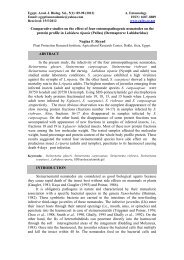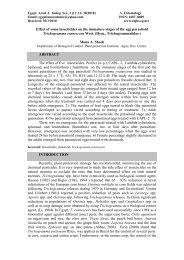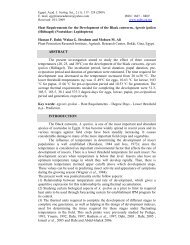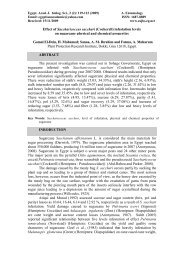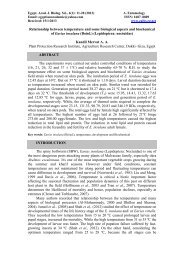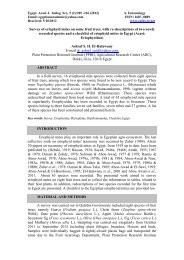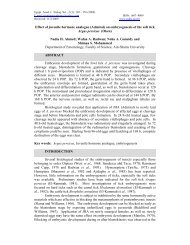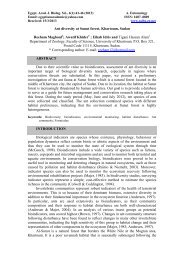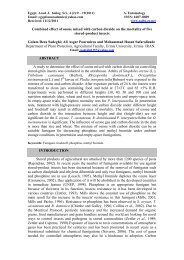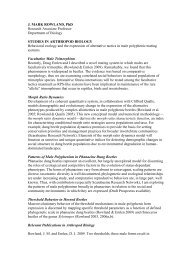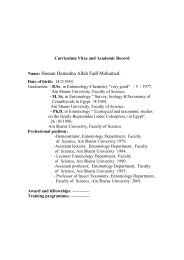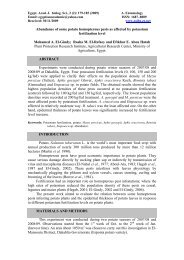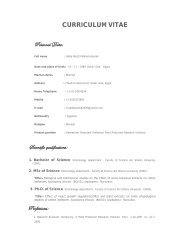Scale insects (Hemiptera: Coccoidea) - egyptian academic journal ...
Scale insects (Hemiptera: Coccoidea) - egyptian academic journal ...
Scale insects (Hemiptera: Coccoidea) - egyptian academic journal ...
Create successful ePaper yourself
Turn your PDF publications into a flip-book with our unique Google optimized e-Paper software.
Egypt. Acad. J. Biolog. Sci., 5(1): 25-29(2012) A. Entomology<br />
Email: <strong>egyptian</strong><strong>academic</strong>@yahoo.com ISSN: 1687–8809<br />
Received: 20/1/2012 www.eajbs.eg.net<br />
<strong>Scale</strong> <strong>insects</strong> (<strong>Hemiptera</strong>: <strong>Coccoidea</strong>) infesting apple, apricot, pear trees and<br />
their abundant parasitoids in Egypt<br />
Shaaban Abd-Rabou, Noha Ahmed and Hoda Badary<br />
Plant Protection Research Institute, Agricultural Research Center, Dokki, Giza<br />
ABSTRACT<br />
<strong>Scale</strong> <strong>insects</strong> are the major pests infesting apple, apricot and pear trees in Egypt.<br />
The aim of the present work is to study a survey of scale <strong>insects</strong> infesting apple,<br />
apricot, pear trees and their abundant parasitoids in Egypt. A survey of scale <strong>insects</strong><br />
infested apple, apricot, pear trees and their abundant parasitoids were carried out all<br />
over Egypt during 2009-2011. The results indicated that apple, apricot and pear trees<br />
were infested by 19, 10 and 10 scale insect species and associated with 12,6 and 8<br />
parasitoid species, respectively.<br />
Key words: <strong>Scale</strong> <strong>insects</strong>, apple, apricot, pear trees, Egypt<br />
INTRODUCTION<br />
<strong>Scale</strong> <strong>insects</strong> are the major pests infesting apple, apricot and pear orchards in<br />
Egypt. Abd-Rabou (2003) and Bakr et al. (2009) reviewed the scale <strong>insects</strong> infested<br />
different crops in Egypt. <strong>Scale</strong> <strong>insects</strong> feed on plant sap. <strong>Scale</strong> feeding slowly reduces<br />
plant vigor, heavily infested plants grow poorly and suffer dieback of twigs and<br />
branches. An infested host is occasionally so weakened that it dies. <strong>Scale</strong>s often<br />
secrete a sticky honeydew which supports the growth of black sooty molds.<br />
Eleven armored scale insect species attacking 62 host plant species including<br />
apple, apricot and pear (Hammad and Moussa, 1973). The host of. Parlatoria oleae<br />
(Colvee) (<strong>Hemiptera</strong>: Diaspididae) was apple (El-Minshawy et al.,1974). Russellaspis<br />
pustulans (Cockerell) (<strong>Hemiptera</strong>: Asterlecaniidae) attacked apple trees in Egypt<br />
(Mangoud, 1994). The parasitoids attacking scale <strong>insects</strong> in Egypt studied by Priesner<br />
and Hosny (1940), Hafez (1988), Abd-Rabou (1997, a, b, 1999, 2000, 2001, 2001a),<br />
Awadallah et al.(1999) and Evans and Abd-Rabou (2005).<br />
The aim of the present work is to study a survey of scale <strong>insects</strong> infesting apple,<br />
apricot. pear and their abundant parasitoids in Egypt.<br />
MATERIALS AND METHODS<br />
A survey on scale <strong>insects</strong> infested apple, apricot, pear trees and their abundant<br />
parasitoids were carried out all over Egypt during 2009-2011. Infested plants with<br />
scale <strong>insects</strong> were examined in the field, using a pocket lens. Leaves, stems and twigs<br />
were collected and placed separately in paper bags for further examination in the<br />
laboratory. Identification of scale <strong>insects</strong> was made by examining its adult in Canada<br />
Balsam, according to Abd-Rabou (2001). Thereafter, the leaves and twigs were kept<br />
in a closed paper bags and transferred to the laboratory for further examination and<br />
counting. Each leave was stored in a well-ventilated emergence glass tube and<br />
monitored daily for parasitoid emergence.
26<br />
RESULTS AND DISCUSSION<br />
Shaaban Abd-Rabou, et al.<br />
As shown in Table (1) the apple trees were infested by 19 scale insect species:<br />
11species belonging to Family Diaspididae, three species belonging to family<br />
Pseudococcidae, three species belonging to family Margarodidae and one species of<br />
families Asterlecaniidae and Coccidae. During the present work 12 parasitoid species<br />
recorded associated with aforementioned scale <strong>insects</strong> . Table (2) showed that apricot<br />
trees infested by 10 scale insect species: 7 species belonging to Family Diaspididae<br />
and one species of families Asterlecaniidae, Coccidae and Pseudococcidae. The<br />
present work 6 parasitoid species recorded associated with aforementioned scale<br />
<strong>insects</strong>.<br />
Table 1: List of scale <strong>insects</strong> infesting apple trees and their abundant parasitoids in Egypt<br />
Species Family Abundant Parasitoids Date<br />
1. Aspidiotus hederae (Vallot) Diaspididae Aphytis chrysomphali (Mercet) June, 2010<br />
2. Dynaspidiotus britannicus Diaspididae Aphytis lingnanensis Comepre November, 2011<br />
(Newstead)<br />
3.Hemiberlesia rapax (Comstock) Diaspididae Encarsia citrina (Craw) August, 2010<br />
4. Hemiberlesia latania (Signort) Diaspididae Encarsia citrina (Craw) September, 2010<br />
5. Icerya aegyptiaca (Douglas) Margarodidae Non October, 2010<br />
6. Icerya purchasi Maskell Margarodidae Non June, 2010<br />
7. Icerya seychellarum (Westwood) Margarodidae Non July, 2009<br />
8. Kilifa acuminata (Signoret) Coccidae Coccophagus scutellaris (Dalman) November, 2010<br />
9. Lepidosaphes beckii (Newman) Diaspididae Aphytis lingnanensis Comepre July, 2009<br />
10. Lepidosaphes gloverii (Packard) Diaspididae Aphytis mytilaspidis (Le Baron) October, 2009<br />
11. Lepidosaphes pallidula (Williams) Diaspididae Aphytis chrysomphali (Mercet) August, 2010<br />
12. Lepidosaphes ulmi (Linnaeus) Diaspididae Encarsia citrina (Craw) June,2010<br />
13. Maconellicoccs hirsutus (Green) Pseudococcidae Leptomastix flava Mercet June, 2010<br />
14. Melanaspis inopinata (Leonardi) Diaspididae Pteroptrix aegyptica Evans & Abd-<br />
Rabou<br />
October, 2011<br />
15. Mycetaspis personata (Comstock) Diaspididae Encarsia citrina (Craw) June, 2011<br />
16. Parlatoria oleae (Colvee) Diaspididae Aphytis maculicornis (Mercet) July, 2009<br />
17. Planococcus ficus (Signoret) Pseudococcidae Neoplatycerus kemticus Trjapitzin and<br />
Triapitsyn<br />
September, 2010<br />
18. Planococcus citri (Risso) Pseudococcidae Leptomastidea abnormis (Girault) June, 2011<br />
19. Russellaspis pustulans (Cockerell) Asterolecaniidae Metaphycus asterolecanii (Mercet) August, 2010<br />
Table 2: List of scale <strong>insects</strong> infesting apricot trees and their abundant parasitoids in Egypt<br />
Species Family Abundant Parasitoids Date<br />
1. Aonidiella aurantii (Maskell), Diaspididae Encarsia citrine (Craw) October, 2009<br />
2. Aonidiella orientalis (Maskell) Diaspididae Pteroptrix aegyptica Evans &<br />
Abd-Rabou<br />
August, 2010<br />
3. Aulacaspis rosae (Bouche) Diaspididae Habrolepis aspidioti Compere<br />
& Annecke<br />
June,2010<br />
4. Aulacaspis tubercularis Newstead Diaspididae Habrolepis aspidioti Compere<br />
& Annecke<br />
September, 2011<br />
5. Chrysomphalus dictyospermi (Morgan) Diaspididae Pteroptrix aegyptica Evans &<br />
Abd-Rabou<br />
July,2009<br />
6. Coccus longulus (Douglas) Coccidae Metaphycus<br />
(Howard)<br />
lounsburyi October, 2011<br />
7. Ferrisia virgata (Cockerell) Pseudococcidae Blepyrus insularis (Cameron) July,2010<br />
8. Hemiberlesia latania (Signort)<br />
Diaspididae Habrolepis aspidioti Compere<br />
& Annecke<br />
September, 2009<br />
9. Melanaspis inopinata (Leonardi) Diaspididae Encarsia citrina (Craw) November, 2011<br />
10. Russellaspis pustulans (Cockerell) Asterolecaniidae Metaphycus asterolecanii<br />
(Mercet)<br />
October, 2011
<strong>Scale</strong> <strong>insects</strong> (<strong>Hemiptera</strong>: <strong>Coccoidea</strong>) infesting apple, apricot 27<br />
While Table (3) showed that pear trees infested by 10 scale insect species: 8<br />
species belonging to Family Diaspididae and one species of Families Coccidae and<br />
Pseudococcidae. Also during the present work 8 parasitoid species recorded<br />
associated with aforementioned scale <strong>insects</strong>.<br />
Table 3: List of scale <strong>insects</strong> infesting pear trees and their abundant parasitoids in Egypt<br />
Species Family Abundant Parasitoids Date<br />
1. Aonidiella aurantii (Maskell) Diaspididae Encarsia citrina (Craw) July,2009<br />
2. Hemiberlesia rapax (Comstock) Diaspididae Pteroptrix aegyptica Evans &<br />
Abd-Rabou<br />
June, 2010<br />
3. Lepidosaphes beckii (Newman) Diaspididae Aphytis lingnanensis Comepre September,2010<br />
4. Lepidosaphes gloverii (Packard) Diaspididae Encarsia citrina (Craw) June, 2010<br />
5. Melanaspis inopinata (Leonardi) Diaspididae Aphytis chrysomphali (Mercet) October,<br />
2011<br />
6. Mycetaspis personata (Comstock) Diaspididae Aphytis sinaii Abd-Rabou October, 2010<br />
7. Parasaissetia nigra (Nietner) Coccidae Microterys flavus (Howard) July,2010<br />
8. Parlatoreopsis longispina Diaspididae Aphytis chrysomphali (Mercet) September, 2011<br />
(Newstead)<br />
9. Parlatoria oleae (Colvee) Diaspididae Aphytis diaspidis (Howard) November, 2010<br />
10. Planococcus citri (Risso) Pseudococcidae Leptomastidea<br />
(Girault)<br />
abnormis September, 2009<br />
Eleven armored scale insect species attacking 62 host plant species including<br />
apple, apricot and pear (Hammad and Moussa, 1973). The host of P. oleae was apple<br />
(El-Minshawy et al., 1974). R. pustulans attacked apple trees in Egypt (Mangoud,<br />
1994).<br />
Abd-Rabou (1997b) recorded that the parasitoid, Aphytis chrysomphali (Mercet)<br />
associated with five armored scale <strong>insects</strong> in different locations in Egypt. Aphytis<br />
diaspidis (Howard) was recorded for the first time in Egypt by Priesner & Hosny<br />
(1940).<br />
Hafez (1988) recorded Aphytis lingnanensis Comepre as the most common<br />
species of A. aurantii on Citrus sp. Priesner & Hosny (1940) recorded Aphytis<br />
mytilaspidis (Le Baron) for the first time in Egypt from all over the Nile Delta.<br />
Aphytis sinaii Abd-Rabou was collected in a few numbers by Abd-Rabou (2004).<br />
Encarsia citrina (Craw) was recorded for the first time in Egypt by Priesner & Hosny<br />
(1940). Abd-Rabou (1997a) mentioned that E. citrina should be considered a<br />
promising candidate for utilization in biological control of armored scale <strong>insects</strong> in<br />
Egypt. This species was reared from 8 species of diaspidid scale <strong>insects</strong> and<br />
maximum parasitism rates ranged between 23 and 65%. Pteroptrix aegyptica (Evans<br />
& Abd-Rabou) was recorded for the first time in Egypt by Evans and Abd-Rabou<br />
(2005). Habrolepis aspidioti (Compere & Annecke) was recorded for the first time in<br />
Egypt by Priesner and Hosny (1940). This species reported as an effective parasitoid<br />
on different armored scale <strong>insects</strong> in different locations in Egypt (Abd-Rabou,1997c).<br />
Blepyrus insularis (Cameron) was recorded for the first time in Egypt by Awadallah<br />
et al.(1999). Leptomastidea abnormis (Girault) was recorded for the first time in<br />
Egypt by Abd-Rabou and its reared from M. hirsutus with maximum parasitism rate<br />
was 21% (Abd- Rabou, 2000). Leptomastix dactylopii Howard was recorded for the<br />
first time in Egypt and its was reared from M. hirsutus with maximum parasitism rate<br />
was 8% (Abd- Rabou, 2000). Coccophagus scutellaris (Dalman) collected for the first<br />
time in Egypt by Priesner and Hosny (1940). Metaphycus lounsburyi (Howard) was<br />
recorded for the first time in Egypt by Abd-Rabou(1998). Microterys flavus (Howard)<br />
was recorded for the first time in Egypt and the rate of parasitism of this species on C.<br />
floridensis, averaged 0.8 and 2.4% during the two years under considerations,
28<br />
Shaaban Abd-Rabou, et al.<br />
respectively. Maximum parasitism rates reached 3.4 and 8.0% during Mid Nov. and<br />
early Nov., respectively (Abd-Rabou, 2001b). M. flavus was mass reared and released<br />
at monthly intervals in olive groves infested with S. oleae at three localities in Egypt<br />
and percentages of parasitism increased after releasing from 11 to 35% (Abd-Rabou,<br />
2004).<br />
REFERENCES<br />
Abd-Rabou, S. (1997): Parasitoids attacking the olive scale insect, Paralatoria oleae<br />
(Colvee) (Homoptera : Coccidea : Diaspididae) in Egypt. The first Scientific<br />
Conference of Agricultural Sciences, Assuit, Vol., II: 719-726.<br />
Abd-Rabou, S. (1997a): The role of Encarsia citrina (Hymenoptera: Aphelinidae) in<br />
the biological control of armored scale <strong>insects</strong> (Homoptera: <strong>Coccoidea</strong>:<br />
Diaspididae) in Egypt. Proceeding of the First Scientific Conference of<br />
Agricultural Sciences, Faculty of Agric. Assiut Univ., Vol. II, 711-717.<br />
Abd-Rabou, S. (1997b): Parasitoids attacking some species of scale <strong>insects</strong><br />
(Homoptera: <strong>Coccoidea</strong>: Diaspididae) in Egypt. Proceeding of the First<br />
Scientific Conference of Agricultural Sciences, Faculty of Agric. Assiut Univ.,<br />
Vol. II, 727-736.<br />
Abd-Rabou, S. (1998): The species of genus Metaphycus (Encyritdae : Hymenoptera)<br />
from Egypt. Bull. Soc. Ent. Egypt, 76: 67-74.<br />
Abd-Rabou, S. (1999): Parasitoids attacking the Egyptian species of armored scale<br />
<strong>insects</strong> (Homoptera : Diaspipidae). Egypt J. Agric. Res., 77(3): 1113-1129.<br />
Abd-Rabou, S. (2000): Parasitoids attacking the hibiscus mealybug Maconellicoccus<br />
hirsutus (Green) (Homoptera : Pseudococcidae) in Egypt. Proceeding of the<br />
Scientific Conference of Agricultural Sciences, Faculty of Agric. Assiut Univ.<br />
Vol. II: 661-666.<br />
Abd-Rabou, S. (2001): Parasitoids attacking Mealybugs (Homoptera: Coccidea:<br />
Pseudococcidae) in Egypt. Egypt. J. Agric. Res. 79 (4): 1355-1377.<br />
Abd-Rabou, S. (2001a): Parasitoids attacking soft scales (Homoptera : Coccidea) in<br />
Egypt. Egypt. J. Agric. Res. 79 (3): 859-880.<br />
Abd-Rabou, S. (2003): <strong>Scale</strong> <strong>insects</strong> and their management in Egypt. Adv. Agric.<br />
Res. In Egypt, Vol. (4) 1: 1-63.<br />
Abd-Rabou, S. (2004): First record of some hymenopterous parasitoids of whiteflies,<br />
scale <strong>insects</strong> and leaf miners in Egypt with description of Aphytis sinaii (n.sp.).<br />
Egyptian Journal of Agricultural Research 82(3): 1092.<br />
Awadallah,K.T., Ibrahim,A.M., Atia, A.R. and Nada,S. (1999): Survey of mealybug<br />
parasitoids and their associated hyperparasitoids on certain ornamental host<br />
plants at Giza region. Bull.Ent. Soc. Egypt. 77:97-101.<br />
Bakr, R. A , Badawy, R. M., Mousa, S. F., Hamooda, L. S. and Sahar A.<br />
Atteia(2009) : Ecological and taxonomic studies on the scale <strong>insects</strong> that infest<br />
mango trees at Qaliobiya governorate. Egypt. Acad. J. biolog. Sci., 2 (2): 69- 89.<br />
El-Minshawy, A. M., El-Sawaf, S. K.,Hammad, S. M. and Donia, A. (1974): Survey<br />
of the scale inestcs attacking fruit trees in Alexandria district 1 (Fam.<br />
Diaspididae; Subfam. Diaspidinae, Trib Aspidiotini. Ale. J. Agric. Res 22 (2):<br />
223-32.<br />
Evans, G. and Abd-Rabou, S. (2005): Two new species and additional records of<br />
Egyptian Aphelinidae. Zootaxa, 833: 1-7.
<strong>Scale</strong> <strong>insects</strong> (<strong>Hemiptera</strong>: <strong>Coccoidea</strong>) infesting apple, apricot 29<br />
Hafez, M. (1988): Population fluctuations on parasites of California red scale,<br />
Aonidiella aurantii (Mask) (Homoptera : Diaspididae) in Alexandria. J. App.<br />
Ent., 106 (2): 183-187.<br />
Hammad, S. M. and Moussa, F. H. (1973): The scale <strong>insects</strong> attcking ornemntal plants<br />
in Alexandria area (Egypt). Alexandria J. of Agric. Res. Vol. 21-August No.2<br />
Mangoud, A. A. H. (1994): Toxicological Studies on some Sucking Insects Infesting<br />
Apple Trees. M.Sc. Thesis, Fac. of Agric. Cairo Univ. Cairo, Egypt.<br />
Priesner, A. and Hosny, M. (1940): Notes on parasites and predators of Coccidae and<br />
Aleyrodidae in Egypt. Bull. Soc. Ent. Egypte, 24: 58-70.<br />
ARABIC SUMMARY<br />
رصم ىف اھيلع ةدئاسلا تايليفطلاو ىرثمكلا و شمشملا و حافتلا بيصت ىتلا ةيرشقلا تارشحل<br />
ىرادب ىدھ و دمحأ اھن و هبر دبع نابعش<br />
ةزيج – يقدلا – ةيعارزلا ثوحبلا زكرم – تاتابنلا ةياقو ثوحب دھعم<br />
. رصم ىف ىرثمكلا و شمشملا و حافتلا بيصت ىتلا ةماھلا تارشحلا نم ةيرشقلا تارشحلا<br />
ةدئاسلا تايليفطلاو ىرثمكلاو شمشملاو حافتلا بيصت ىتلا ةيرشقلا تارشحلا رصح ةسارد لمعلا اذھ نم فدھلا<br />
تايليفطلاو ىرثمكلا و شمشملا و حافتلا ىلع ةيرشقلا تارشحلل رصح ةسارد لمع مت دقو رصم ىف اھيلع<br />
و شمشملا و حافتلا راجشأ نأ ىلا جئاتنلا تاراشأ دقو 2011 ىلا 2009 نم ةرتفلا ىف رصم ىف اھيلع ةدئاسلا<br />
ىلع تايليفط 8 و 6 و 12 ل ةبحاصم تلجس و ةيرشقلا تارشحلا نم عونأ<br />
10 و 10و<br />
19 ب باصت ىرثمكلا<br />
.<br />
بيترتلا



